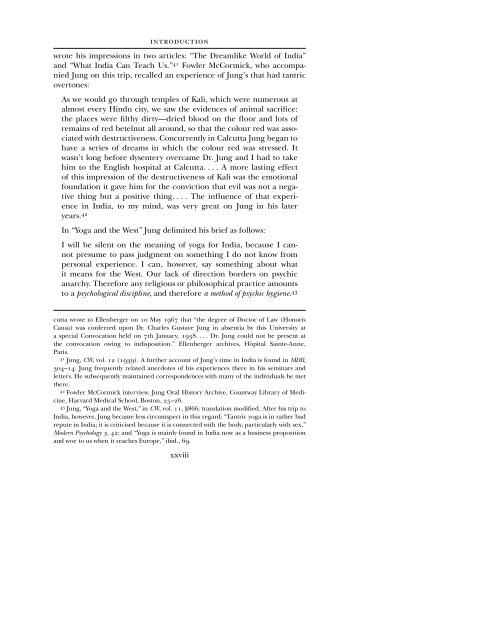CG JUNG - Countryside Anarchist
CG JUNG - Countryside Anarchist
CG JUNG - Countryside Anarchist
Create successful ePaper yourself
Turn your PDF publications into a flip-book with our unique Google optimized e-Paper software.
INTRODUCTION<br />
wrote his impressions in two articles: “The Dreamlike World of India”<br />
and “What India Can Teach Us.” 41 Fowler McCormick, who accompanied<br />
Jung on this trip, recalled an experience of Jung’s that had tantric<br />
overtones:<br />
As we would go through temples of Kali, which were numerous at<br />
almost every Hindu city, we saw the evidences of animal sacrifice:<br />
the places were filthy dirty—dried blood on the floor and lots of<br />
remains of red betelnut all around, so that the colour red was associated<br />
with destructiveness. Concurrently in Calcutta Jung began to<br />
have a series of dreams in which the colour red was stressed. It<br />
wasn’t long before dysentery overcame Dr. Jung and I had to take<br />
him to the English hospital at Calcutta. . . . A more lasting effect<br />
of this impression of the destructiveness of Kali was the emotional<br />
foundation it gave him for the conviction that evil was not a negative<br />
thing but a positive thing. . . . The influence of that experience<br />
in India, to my mind, was very great on Jung in his later<br />
years. 42<br />
In “Yoga and the West” Jung delimited his brief as follows:<br />
I will be silent on the meaning of yoga for India, because I cannot<br />
presume to pass judgment on something I do not know from<br />
personal experience. I can, however, say something about what<br />
it means for the West. Our lack of direction borders on psychic<br />
anarchy. Therefore any religious or philosophical practice amounts<br />
to a psychological discipline, and therefore a method of psychic hygiene. 43<br />
cutta wrote to Ellenberger on 10 May 1967 that “the degree of Doctor of Law (Honoris<br />
Causa) was conferred upon Dr. Charles Gustave Jung in absentia by this University at<br />
a special Convocation held on 7th January, 1938. . . . Dr. Jung could not be present at<br />
the convocation owing to indisposition.” Ellenberger archives, Hôpital Sainte-Anne,<br />
Paris.<br />
41 Jung, CW, vol. 12 (1939). A further account of Jung’s time in India is found in MDR,<br />
304–14. Jung frequently related anecdotes of his experiences there in his seminars and<br />
letters. He subsequently maintained correspondences with many of the individuals he met<br />
there.<br />
42 Fowler McCormick interview, Jung Oral History Archive, Countway Library of Medicine,<br />
Harvard Medical School, Boston, 25–26.<br />
43 Jung, “Yoga and the West,” in CW, vol. 11, §866; translation modified. After his trip to<br />
India, however, Jung became less circumspect in this regard: “Tantric yoga is in rather bad<br />
repute in India; it is criticised because it is connected with the body, particularly with sex,”<br />
Modern Psychology 3, 42; and “Yoga is mainly found in India now as a business proposition<br />
and woe to us when it reaches Europe,” ibid., 69.<br />
xxviii


